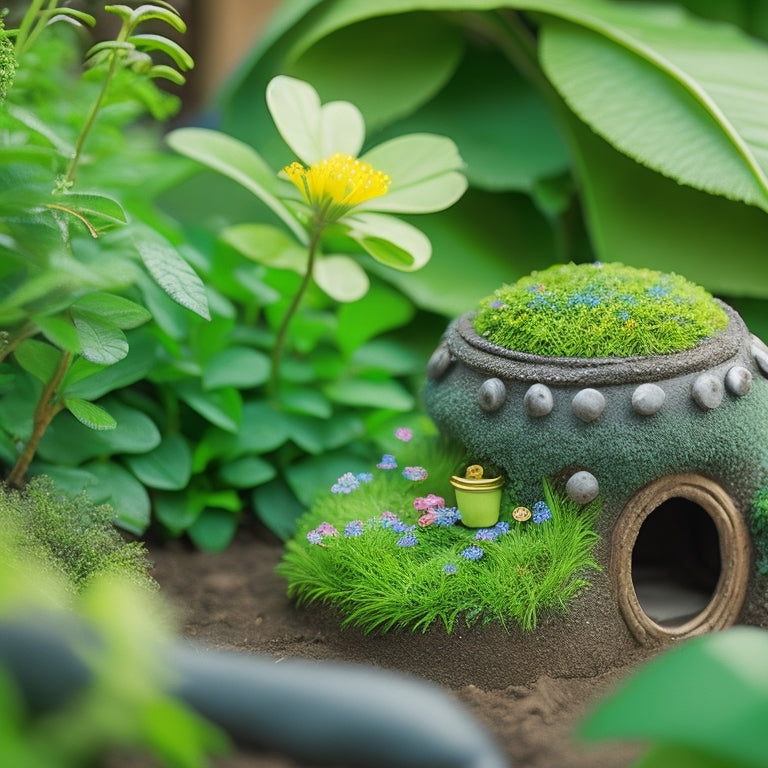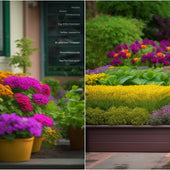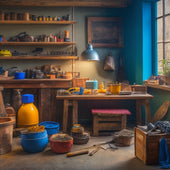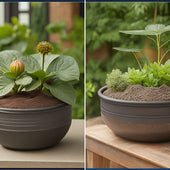
7 Creative Cinder Planter Designs to Try at Home
Share
You can elevate your outdoor space with these 7 creative cinder block planter designs that blend structural stability with visual appeal. Try building a Modern Cinder Block Pyramid Planter with a sturdy base and hollow core for ideal drainage. Create a Colorful Cinder Block Mosaic Planter by arranging blocks in a vibrant pattern. Alternatively, construct a Vertical Cinder Block Garden Wall, a Whimsical Cinder Block Fairy Garden, or a Rustic Cinder Block Herb Planters Box to add texture and depth. Geometric Cinder Block Planters and Cinder Block Tiered Planter Stations offer modern, industrial flair. Now, take the next step to bring your outdoor vision to life.
Key Takeaways
• Create a Modern Cinder Block Pyramid Planter with a sturdy base, hollow core, and decorative capstones for a unique focal point.
• Design a Vertical Cinder Block Garden Wall with a level foundation, offset blocks, and a soil mix designed for vertical gardening.
• Build a Cinder Block Tiered Planter Station with a level base, staggered blocks, and regular maintenance for a thriving display.
• Craft a Colorful Cinder Block Mosaic Planter with arranged blocks, contrasting colors, and a waterproof sealant for a vibrant statement piece.
• Develop a Whimsical Cinder Block Fairy Garden with a meandering pathway, varied textures, and compact plants for a charming miniature world.
Modern Cinder Block Pyramid Planters
Building a modern cinder block pyramid planter begins with calculating the number of blocks needed to achieve the desired height and width, guaranteeing a sturdy base that can support the weight of the soil and plants.
You'll need to take into account the pyramid's slope, too, as a steeper angle will require more blocks.
Once you have your blocks, start building from the base up, using a level to guarantee each layer is even. As you stack the blocks, leave space in the center for the soil and plants.
The pyramid planter benefits from having a hollow core, allowing for better drainage and aeration for the roots.
The modern design aesthetics of this planter are undeniable, with clean lines and a geometric silhouette that adds visual interest to any outdoor space.
You can further enhance the look by adding a decorative capstone or painting the blocks in a bold, contrasting color.
With careful planning and execution, your modern cinder block pyramid planter will be a stunning addition to your garden or patio.
Colorful Cinder Block Mosaic Planter
To create a vibrant Colorful Cinder Block Mosaic Planter, you'll need to gather a variety of colored concrete blocks, or paint and seal existing ones, to craft a visually striking design that adds a pop of color to your outdoor space.
Once you have your blocks, arrange them to form a mosaic pattern, experimenting with different color combinations to find the one that resonates with you. You can use contrasting colors to create a bold, geometric design or opt for a more subtle, ombre-inspired look.
To add an extra layer of visual interest, incorporate different mosaic techniques, such as staggered joints or diagonal patterns, to create a dynamic, eye-catching design.
As you build your planter, make certain to leave space for drainage and aeration to guarantee your plants thrive.
Finally, seal your planter with a waterproof sealant to protect it from the elements and make certain it remains vibrant for years to come.
With a little creativity and patience, you'll have a stunning Colorful Cinder Block Mosaic Planter that adds a burst of color and personality to your outdoor space.
Vertical Cinder Block Garden Wall
By stacking cinder blocks vertically, you can create a sturdy and space-efficient Vertical Cinder Block Garden Wall that showcases a lush tapestry of plants and adds depth to your outdoor space. This design takes advantage of vertical gardening benefits, maximizing space while minimizing footprint. The cinder block durability guarantees the structure can support the weight of soil and plants, even in harsh weather conditions.
To build your wall, start by laying a level foundation of cinder blocks. Then, stack blocks on top of each other, leaving space between for drainage and aeration. As you add layers, offset the blocks to create a staggered pattern, adding visual interest to the design.
Fill the gaps with a soil mix specifically designed for vertical gardening, and plant your chosen species. Consider using a mix of plants with varying textures and colors to create a visually appealing display.
With proper care, your Vertical Cinder Block Garden Wall will thrive, providing a beautiful focal point for your outdoor space.
Whimsical Cinder Block Fairy Garden
As you design your whimsical cinder block fairy garden, you'll want to contemplate the layout that will best showcase your miniature world.
You'll need to decide on a configuration that balances paths, plants, and decorative features, all while leaving room for your fairy friends to roam.
Fairy Garden Layout
Create a whimsical fairy garden layout by stacking cinder blocks to form a meandering pathway that winds its way through a lush, verdant landscape filled with tiny flora and miniature garden ornaments.
You can create a sense of depth by layering the blocks to create different levels, with smaller plants and fairy garden accessories nestled in the nooks and crannies.
To add visual interest, incorporate varied textures and colors by combining smooth stones, moss, and small shrubs.
Consider creating a focal point, such as a miniature bridge or a tiny water feature, to draw the eye through the landscape.
When selecting plants, choose varieties that are compact and slow-growing, such as thyme, succulents, or miniature roses.
In miniature landscape design, scale is key, so opt for plants that will remain small and won't overwhelm the space.
Whimsical Block Arrangement
You'll establish a whimsical foundation for your fairy garden by arranging cinder blocks in a playful, organic pattern, where each block is intentionally placed to evoke a sense of spontaneity and curiosity.
This creative block stacking technique will add visual interest to your garden, creating a unique canvas for your whimsical plant arrangements.
Start by grouping blocks of varying sizes and shapes, experimenting with different heights and angles to create a sense of movement. Leave gaps between the blocks to create pathways for your fairy friends to explore.
As you stack, consider the visual flow of your arrangement, balancing tall blocks with shorter ones and creating a sense of harmony.
To add an extra touch of whimsy, incorporate small decorative elements, such as tiny furniture, seashells, or moss, into the nooks and crannies between the blocks.
Rustic Cinder Block Herb Planters Box
As you design your rustic cinder block herb planter box, you'll want to contemplate the block design elements that will give your planter its unique character.
Think about the texture and color of the cinder blocks, as well as the pattern in which you'll arrange them.
You'll also need to plan the herb garden layout, deciding which herbs to group together and how to create a visually appealing arrangement.
Block Design Elements
Rustic cinder block herb planters box designs often feature a combination of rectangular and square blocks arranged in a staggered pattern to add visual interest and create a sense of depth.
This block design element is essential in creating a functional design that's both aesthetically pleasing and functional. By using a mix of block shapes and sizes, you can create a visually appealing planter that adds texture and dimension to your outdoor space.
When designing your rustic cinder block herb planters box, consider the following block design elements to enhance the aesthetic appeal:
-
Use a combination of rectangular and square blocks to create a staggered pattern
-
Alternate the direction of the blocks to add visual interest
-
Vary the size of the blocks to create a sense of depth and dimension
-
Use a mix of smooth and rough-textured blocks to add texture
-
Leave some blocks unpainted to create a natural, rustic look
Herb Garden Layout
To create an efficient herb garden layout in your cinder block planter box, start by dividing the space into separate compartments or sections, each dedicated to a specific herb or plant group, depending on their growth habits and sunlight requirements. This will guarantee that each herb receives the right amount of sunlight and water.
Consider herb companion planting principles, where certain herbs are paired together to enhance growth and flavor. For example, plant basil with tomatoes and mint with lemon balm.
Next, think vertically by incorporating a vertical herb garden element to maximize space. You can attach a trellis or a wall-mounted planter to the side of your cinder block planter box. This will allow you to grow vining herbs like mint, lemongrass, or rosemary, while keeping the base of the planter free for smaller herbs like thyme, oregano, or chives.
Geometric Cinder Block Planters Design
You can create visually striking geometric cinder block planters by arranging blocks in a pattern that juxtaposes rectangular and triangular shapes, resulting in a modern, architectural design. This design style is perfect for those who appreciate clean lines, symmetry, and a touch of industrial chic.
By carefully planning your block arrangement, you can create a planter that's both functional and visually appealing.
To achieve planter symmetry, consider the following tips:
-
Use a mix of rectangular and triangular blocks to add visual interest
-
Alternate block orientations to create a sense of movement
-
Balance large blocks with smaller ones to prevent the planter from looking too bulky
-
Play with different block heights to add depth and dimension
-
Experiment with different block arrangements to find a pattern that resonates with your personal style
Cinder Block Tiered Planter Station
Building a cinder block tiered planter station allows you to create a visually stunning display of plants and flowers, with each level providing a unique opportunity to showcase different textures, colors, and blooms.
To achieve this, start by laying the foundation with a level base of cinder blocks, guaranteeing they're securely stacked and aligned. As you add each tier, make certain to stagger the blocks to create a sturdy structure.
When it comes to planting, consider using a mix of plants with varying heights and spreads to create visual interest. Planting techniques such as layering and grouping can add depth and dimension to your display.
To maintain your cinder block planter station, make certain to perform regular cinder block maintenance, such as cleaning and sealing the blocks to prevent weathering. This will guarantee your planter station remains a beautiful focal point in your outdoor space.
Frequently Asked Questions
Can I Use Cinder Blocks With Cracks or Broken Edges?
When working with cinder blocks, you'll inevitably encounter ones with cracks or broken edges. But don't dismiss them just yet! While they may not be ideal, you can still use them with some creative repair techniques.
Assess the block's durability by inspecting the crack's depth and width. If it's shallow and not compromising the block's structure, you can fill it with a durable sealant or concrete patching compound.
This will restore the block's integrity, making it suitable for your planter project.
How Do I Prevent Weeds From Growing in My Cinder Block Planters?
When creating your planters, you'll want to prevent weeds from taking over.
Start by lining the bottom of each block with landscape fabric or a weed barrier to block seed germination.
Next, add a layer of compacted gravel for drainage solutions.
Finally, fill with a mix of soil and organic matter, and consider mulching to further suppress weeds.
Are Cinder Blocks Safe for Plants and Soil?
Oh, you thought cinder blocks were a harmless, rustic addition to your garden, didn't you? Think again!
Cinder blocks can leach toxic chemicals into your soil, affecting its pH levels and potentially harming your plants.
But fear not, green thumb! Most cinder blocks are made from fly ash, which is relatively inert.
However, it's still essential to test your soil pH regularly to guarantee it's not becoming too alkaline.
With proper monitoring, you can enjoy your cinder block planters without worrying about toxicity.
Can I Paint or Stain Cinder Blocks for a Decorative Look?
You're wondering if you can paint or stain cinder blocks for a decorative look.
Absolutely! Painting or staining cinder blocks is a great way to add personality to your planters.
You'll have endless color options to choose from, and various painting techniques to experiment with, like ombre or stenciling.
Make certain to prime the blocks first, and use exterior-grade paint or stain to guarantee durability.
With a little creativity, you'll create a stunning, one-of-a-kind planter that showcases your unique style.
How Do I Clean and Maintain My Cinder Block Planters?
You'll want to clean your cinder block planters regularly to prevent dirt buildup and maintain their appearance.
Use a gentle cleaning technique, mixing 1 tablespoon of mild detergent with 1 gallon of warm water. Scrub the blocks with a soft-bristled brush, then rinse thoroughly. For tougher stains, try a 1:1 vinegar-water solution.
For maintenance, seal your planters with a waterproofing spray every 6-12 months to protect them from the elements. Regularly inspect for cracks and repair promptly to prevent water damage.
Conclusion
You've just unsealed a treasure trove of creative cinder planter designs to transform your outdoor space!
With these 7 innovative ideas, your backyard will be overflowing with style and greenery in no time.
Imagine a whimsical fairy garden, a modern pyramid planter, or a geometric masterpiece that'll make your neighbors green with envy - the possibilities are endless!
Related Posts
-

Optimal Soil Ph for Planter Boxes Made Easy
You need to optimize your planter box's soil pH to create a thriving environment for your plants, as the ideal pH ran...
-

Optimal Soil Ph for Planter Boxes Made Easy
You need to optimize your planter box's soil pH to create a thriving environment for your plants, as the ideal pH ran...
-

Optimal Soil Ph for Planter Boxes Made Easy
You need to optimize your planter box's soil pH to create a thriving environment for your plants, as the ideal pH ran...
-

Optimal Soil Ph for Planter Boxes Made Easy
You need to optimize your planter box's soil pH to create a thriving environment for your plants, as the ideal pH ran...
-

Optimal Soil Ph for Planter Boxes Made Easy
You need to optimize your planter box's soil pH to create a thriving environment for your plants, as the ideal pH ran...
-

Optimal Soil Ph for Planter Boxes Made Easy
You need to optimize your planter box's soil pH to create a thriving environment for your plants, as the ideal pH ran...
-

Optimal Soil Ph for Planter Boxes Made Easy
You need to optimize your planter box's soil pH to create a thriving environment for your plants, as the ideal pH ran...
-

Optimal Soil Ph for Planter Boxes Made Easy
You need to optimize your planter box's soil pH to create a thriving environment for your plants, as the ideal pH ran...
-

Optimal Soil Ph for Planter Boxes Made Easy
You need to optimize your planter box's soil pH to create a thriving environment for your plants, as the ideal pH ran...
-

Optimal Soil Ph for Planter Boxes Made Easy
You need to optimize your planter box's soil pH to create a thriving environment for your plants, as the ideal pH ran...
-

Optimal Soil Ph for Planter Boxes Made Easy
You need to optimize your planter box's soil pH to create a thriving environment for your plants, as the ideal pH ran...
-

Optimal Soil Ph for Planter Boxes Made Easy
You need to optimize your planter box's soil pH to create a thriving environment for your plants, as the ideal pH ran...
-

Optimal Soil Ph for Planter Boxes Made Easy
You need to optimize your planter box's soil pH to create a thriving environment for your plants, as the ideal pH ran...
-

Optimal Soil Ph for Planter Boxes Made Easy
You need to optimize your planter box's soil pH to create a thriving environment for your plants, as the ideal pH ran...
-

Optimal Soil Ph for Planter Boxes Made Easy
You need to optimize your planter box's soil pH to create a thriving environment for your plants, as the ideal pH ran...
-

Optimal Soil Ph for Planter Boxes Made Easy
You need to optimize your planter box's soil pH to create a thriving environment for your plants, as the ideal pH ran...
-

Optimal Soil Ph for Planter Boxes Made Easy
You need to optimize your planter box's soil pH to create a thriving environment for your plants, as the ideal pH ran...
-

Optimal Soil Ph for Planter Boxes Made Easy
You need to optimize your planter box's soil pH to create a thriving environment for your plants, as the ideal pH ran...
-

Optimal Soil Ph for Planter Boxes Made Easy
You need to optimize your planter box's soil pH to create a thriving environment for your plants, as the ideal pH ran...
-

Optimal Soil Ph for Planter Boxes Made Easy
You need to optimize your planter box's soil pH to create a thriving environment for your plants, as the ideal pH ran...
-

Optimal Soil Ph for Planter Boxes Made Easy
You need to optimize your planter box's soil pH to create a thriving environment for your plants, as the ideal pH ran...
-

Optimal Soil Ph for Planter Boxes Made Easy
You need to optimize your planter box's soil pH to create a thriving environment for your plants, as the ideal pH ran...
-

Optimal Soil Ph for Planter Boxes Made Easy
You need to optimize your planter box's soil pH to create a thriving environment for your plants, as the ideal pH ran...
-

Optimal Soil Ph for Planter Boxes Made Easy
You need to optimize your planter box's soil pH to create a thriving environment for your plants, as the ideal pH ran...
-

Optimal Soil Ph for Planter Boxes Made Easy
You need to optimize your planter box's soil pH to create a thriving environment for your plants, as the ideal pH ran...
-

Optimal Soil Ph for Planter Boxes Made Easy
You need to optimize your planter box's soil pH to create a thriving environment for your plants, as the ideal pH ran...
-

3 Best Tool Essentials for Creative Concrete Planters
To create visually stunning and durable concrete planters, you'll need three essential tool categories. First, you'll...
-

3 Best Tool Essentials for Creative Concrete Planters
To create visually stunning and durable concrete planters, you'll need three essential tool categories. First, you'll...
-

3 Best Tool Essentials for Creative Concrete Planters
To create visually stunning and durable concrete planters, you'll need three essential tool categories. First, you'll...
-

3 Best Tool Essentials for Creative Concrete Planters
To create visually stunning and durable concrete planters, you'll need three essential tool categories. First, you'll...
-

3 Best Tool Essentials for Creative Concrete Planters
To create visually stunning and durable concrete planters, you'll need three essential tool categories. First, you'll...
-

3 Best Tool Essentials for Creative Concrete Planters
To create visually stunning and durable concrete planters, you'll need three essential tool categories. First, you'll...
-

3 Best Tool Essentials for Creative Concrete Planters
To create visually stunning and durable concrete planters, you'll need three essential tool categories. First, you'll...
-

3 Best Tool Essentials for Creative Concrete Planters
To create visually stunning and durable concrete planters, you'll need three essential tool categories. First, you'll...
-

3 Best Tool Essentials for Creative Concrete Planters
To create visually stunning and durable concrete planters, you'll need three essential tool categories. First, you'll...
-

3 Best Tool Essentials for Creative Concrete Planters
To create visually stunning and durable concrete planters, you'll need three essential tool categories. First, you'll...
-

3 Best Tool Essentials for Creative Concrete Planters
To create visually stunning and durable concrete planters, you'll need three essential tool categories. First, you'll...
-

3 Best Tool Essentials for Creative Concrete Planters
To create visually stunning and durable concrete planters, you'll need three essential tool categories. First, you'll...
-

3 Best Tool Essentials for Creative Concrete Planters
To create visually stunning and durable concrete planters, you'll need three essential tool categories. First, you'll...
-

3 Best Tool Essentials for Creative Concrete Planters
To create visually stunning and durable concrete planters, you'll need three essential tool categories. First, you'll...
-

What Depth Is Best for My Planter
When selecting a planter, consider the root depth requirements of your chosen plant species, as this dictates the min...
-

What Depth Is Best for My Planter
When selecting a planter, consider the root depth requirements of your chosen plant species, as this dictates the min...
-

What Depth Is Best for My Planter
When selecting a planter, consider the root depth requirements of your chosen plant species, as this dictates the min...
-

What Depth Is Best for My Planter
When selecting a planter, consider the root depth requirements of your chosen plant species, as this dictates the min...
-

What Depth Is Best for My Planter
When selecting a planter, consider the root depth requirements of your chosen plant species, as this dictates the min...
-

What Depth Is Best for My Planter
When selecting a planter, consider the root depth requirements of your chosen plant species, as this dictates the min...
-

What Depth Is Best for My Planter
When selecting a planter, consider the root depth requirements of your chosen plant species, as this dictates the min...
-

What Depth Is Best for My Planter
When selecting a planter, consider the root depth requirements of your chosen plant species, as this dictates the min...
-

What Depth Is Best for My Planter
When selecting a planter, consider the root depth requirements of your chosen plant species, as this dictates the min...
-

What Depth Is Best for My Planter
When selecting a planter, consider the root depth requirements of your chosen plant species, as this dictates the min...
-

What Depth Is Best for My Planter
When selecting a planter, consider the root depth requirements of your chosen plant species, as this dictates the min...
-

What Depth Is Best for My Planter
When selecting a planter, consider the root depth requirements of your chosen plant species, as this dictates the min...
-

What Depth Is Best for My Planter
When selecting a planter, consider the root depth requirements of your chosen plant species, as this dictates the min...
-

What Depth Is Best for My Planter
When selecting a planter, consider the root depth requirements of your chosen plant species, as this dictates the min...
-

What Depth Is Best for My Planter
When selecting a planter, consider the root depth requirements of your chosen plant species, as this dictates the min...
-

What Depth Is Best for My Planter
When selecting a planter, consider the root depth requirements of your chosen plant species, as this dictates the min...
-

What Depth Is Best for My Planter
When selecting a planter, consider the root depth requirements of your chosen plant species, as this dictates the min...
-

What Depth Is Best for My Planter
When selecting a planter, consider the root depth requirements of your chosen plant species, as this dictates the min...
-

What Depth Is Best for My Planter
When selecting a planter, consider the root depth requirements of your chosen plant species, as this dictates the min...
-

What Depth Is Best for My Planter
When selecting a planter, consider the root depth requirements of your chosen plant species, as this dictates the min...
-

What Depth Is Best for My Planter
When selecting a planter, consider the root depth requirements of your chosen plant species, as this dictates the min...


